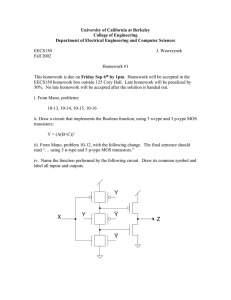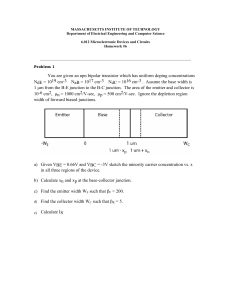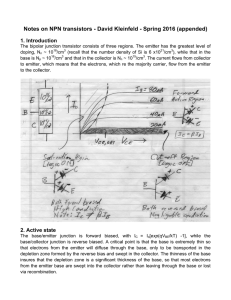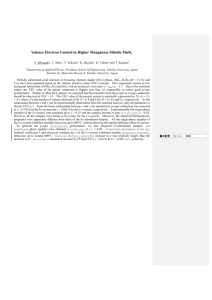Small Signal Diode Models
advertisement
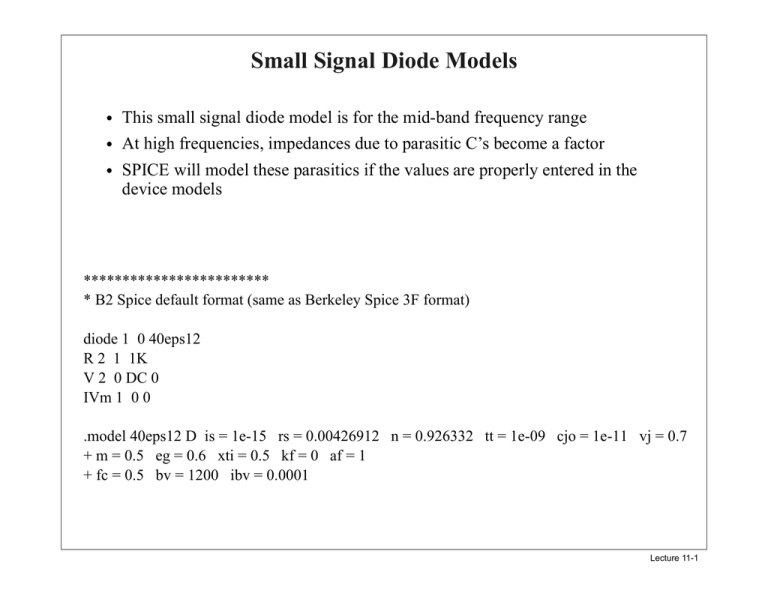
Small Signal Diode Models • This small signal diode model is for the mid-band frequency range • At high frequencies, impedances due to parasitic C’s become a factor • SPICE will model these parasitics if the values are properly entered in the device models ************************ * B2 Spice default format (same as Berkeley Spice 3F format) diode 1 0 40eps12 R 2 1 1K V 2 0 DC 0 IVm 1 0 0 .model 40eps12 D is = 1e-15 rs = 0.00426912 n = 0.926332 tt = 1e-09 cjo = 1e-11 vj = 0.7 + m = 0.5 eg = 0.6 xti = 0.5 kf = 0 af = 1 + fc = 0.5 bv = 1200 ibv = 0.0001 Lecture 11-1 Junction (Depletion) Capacitance • Depletion capacitance in terms of SPICE3 model parameters C jo C j = ----------------------- V D m 1 – ------- Vj • This is the dominant capacitance component under reverse bias conditions • It is also present under forward bias conditions --- since there is a depletion region • For forward bias, this equation is not very accurate, and 2Cjo is used (why is it greater than Cjo?) • But this is not the dominant component for forward bias Lecture 11-2 Forward Bias Small Signal Diode Models • Dominant capacitance is due to stored diffusion charge • If n-side is more lightly doped than p-side, then diffusion current is dominated by holes injected into the n-side Qp ------- = I p τp ∆p ( 0 ) ∝ e v Ip pno • SPICE models this in terms of an average transit time, the average time a hole stays in the n region of the diode (or: an electron stays in the p region) Qp = Ip τT Lecture 11-3 Diode Models • The corresponding capacitance is nonlinear, but can be specified at an operating point • What does the complete diode SPICE model look like? Lecture 11-4 Small Signal SPICE Diode Models • What does the small signal diode model look like after determining the dc operating point? Lecture 11-5 Asymmetrical diode • In the asymmetrical junction (p+n or n+p), the lightly doped region is sometimes called “the base” • Usually, most of the current flowing through a p+n or n+p junction is due to injection of minority carriers into “base” from the highly doped region. n+ + __ + _ + _ + _ + p ∆np pno ∆pn npo equilibrium value Lecture 11-6 Short base vs long base • How far, on average, a minority carrier goes in the base depends upon: - Diffusion constant Dn (how fast the particles flow) - Minority carrier lifetime τn (how long a particle survives on average) • We define a diffusion length of electrons in p type Si: τn D Ln = n+ n p W excess minority carrier concentration excess minority carrier concentration almost all recombines in base almost nothing recombines in base W << Ln W >> Ln Lecture 11-7 Bipolar Junction Transistors --- BJTs • Bipolar refers to the conduction of both holes and electrons • Two connected p-n junctions • But unlike diodes, provides gain/amplification -- behaves like a controlled source • Terminology: CBJ EBJ Emitter n-type p-type n-type Collector NPN Transistor Base Lecture 11-8 Regions of Operation for NPN Transistor • Cut-off: both p-n junctions are reverse biased • Saturation: both p-n junctions are forward biased • Active: the EBJ is forward biased and the CBJ is reverse biased EBJ Emitter n-type CBJ p-type n-type Collector Base NPN Transistor Lecture 11-9 PNP Bipolar Junction Transistor • Regions of operation are characterized in the same way • Cut-off: both p-n junctions are reverse biased • Saturation: both p-n junctions are forward biased • Active: the EBJ is forward biased and the CBJ is reverse biased CBJ EBJ Emitter p-type n-type p-type Collector Base PNP Transistor Lecture 11-10 PNP and NPN Transistors in Active Region • Active: the EBJ is forward biased and the CBJ is reverse biased NPN Transistor PNP Transistor Lecture 11-11 Active Region Operation n-type p-type n-type C E W VBE VCB B W x • Electrons are injected from the emitter and diffuse to the collector • Most of the electrons will reach the collector --- depends on W and τF • Excess carrier concentration at CBJ is zero since electric field collects everything Lecture 11-12 Active Region Operation • The maximum np concentration at EBJ depends on the VBE • The slope of the npdistribution determines the diffusion current from collector to emitter dn p i c ∝ --------dx E n-type p-type C n-type W VBE VCB B W x Lecture 11-13 Active Region Operation • But some of the carriers in the base recombine • Electrons lost to recombination correspond to holes supplied to the base --- a current ib • The distribution is no longer linear E n-type p-type C n-type W VBE VCB B W x Lecture 11-14 Active Region Operation • Why does the distribution change in a convex, as opposed to concave manner? E n-type p-type C n-type W VBE VCB B W x • ic is practically independent of VCB. Why? Lecture 11-15 Active Region Operation • Assuming that there is no recombination in the base and no injection from base to emitter, the collector current, ic is simply ic = Is e v be ⁄ V T • Is is ~ 10-12 to 10-15, and directly proportional to the EBJ area • On ICs the EBJ junctions can be used to scale one transistor size (hence current) relative to another E p B C n+ n Lecture 11-16 Base Current • ib1: Component due to holes from external ckt replacing those lost via recombination in the base • ib2: dominant portion comes from holes injected from the base to emitter E n-type p-type VBE B C n-type VCB pn is proportional to doping level in the base and e v be ⁄ V T x Lecture 11-17 Base Current • Recombination current, ib1 is also proportional to e v be ⁄ V T • Therefore, the total base current is proportional to ic ic = Is e v be ⁄ V T • The proportionality factor, β , is the common emitter current gain: ic I s v be ⁄ V T i b = ---- = ---- e β β input circuit output circuit • β ≈ 100 – 200 , and is determined by the BE doping levels and the width of the base, W Lecture 11-18 Emitter Current • α < 1 is the common base gain i c = αi e input circuit output circuit • By conservation of charge: ie = ic + ib ic i b = ---β β+1 i e = ------------i β c β α = -----------β+1 α β = -----------1–α Lecture 11-19 Active Region: Controlled Source Behavior • An applied base-emitter voltage, VBE, causes a collector current that is independent of the base-collector voltage (in the active region) • Behaves like a voltage controlled current source • Active region is used for amplification in analog design E n-type p-type VBE B C n-type VCB x Lecture 11-20 Equivalent Circuit Models • Please read about Eber-Moll model in Sec. 4.13 of your textbook! • We can model the transistor behavior in the active region using diodes and controlled sources C ic = Is e ib B v be ⁄ V T ic i e = ---α E C • Or, using a linear current-controlled current sources and diodes i c = αi e ib ic I s v be ⁄ V T i e = ---- = ---- e α α B E Lecture 11-21 Equivalent Circuit Models • The circuit models on the previous page represent the transistor in terms of the common-base current gain --- gain from iE to iC C i c = αi e ib I s v be ⁄ V T i e = ---- e α B E • A common emitter configuration is sometimes more useful ic I s v be ⁄ V T i b = ---- = ---- e β β C ic = Is e B E v be ⁄ V T = βi b ie Lecture 11-22 Active Region Currents • The only current we’ve ignored is a negligible one, ICBO, the leakage current from the collector to the base • ICBO is measured like a reverse-biased diode current with the emitter open circuited • Like the saturation current of a diode, ICBO is small and temperature dependent ICBO E n-type p-type B n-type C VCB Lecture 11-23 PNP: Active Region • Operates the same way as the NPN, but the applied voltages are reversed for the active region --- EBJ is forward biased and CBJ is reverse biased E p-type n-type VEB B C p-type VBC x Lecture 11-24 PNP Equivalent Circuit Models • We can model the PNP in the active region using diodes and controlled sources E ib B I s v eb ⁄ V T i e = ---- e α αi e C • The common emitter configuration is I s v eb ⁄ V T i b = ---- e β E ie B βi b C Lecture 11-25 Collector and Emitter • Note that while the emitter and collector are always of the same type, they are not interchangable! • They’re doping levels are quite different E p B C n+ n If you swap emitter and collector (EBJ reverse biased, CBJ forward) you get socalled inverse mode of operation. It is like active region, but the current transistor usually has much worse performance. Lecture 11-26
